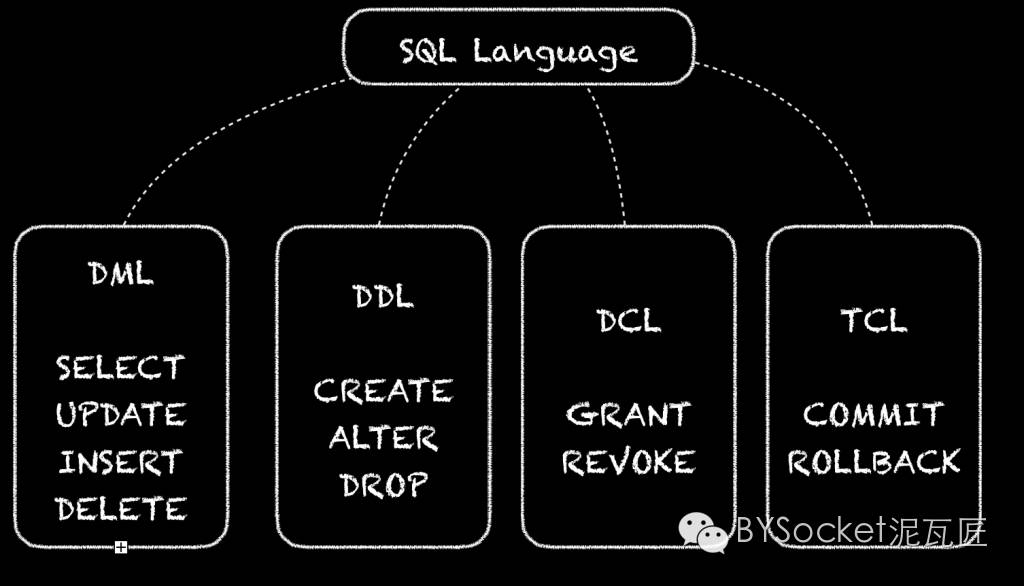Author: Mason Today, the group discussed whether DDL or DML. I'd better summarize their differences.
1. DDL – Data Definition Language
Database definition language: defines the structure of a database.
The main commands are CREATE, ALTER, DROP, etc., which are explained in detail with examples below. The language does not require a commit, so be careful.
CREATE – to create objects in the database
Example: CREATE DATABASE test; // Create a database named test
ALTER – alters the structure of the database
Example: ALTER TABLE test ADD birthday date; // Modify the test table and add a birthday column of date type
DROP – delete objects from the database
Example: DROP DATABASE test;// Delete test database
There are others:
TRUNCATE – TRUNCATE table contents (in development period, it is still very common)
COMMENT – adds a COMMENT to the data dictionary
2. DML – Data Manipulation Language
Database operation language: process the data in the database in SQL
The main commands include SELECT,INSERT,UPDATE,DELETE, etc. These examples are not introduced one by one. The language requires commit. There is also the commonly used LOCK TABLE. Remember to write the lock blog - portal
There are other unfamiliar:
CALL – calls a PL/SQL or Java subroutine EXPLAIN PLAN – parse data access path
3. DCL – Data Control Language
Database control language: authorization, role control, etc
GRANT – give users access
REVOKE – REVOKE authorization
4. TCL – Transaction Control Language
Transaction control language
COMMIT – save the completed work
SAVEPOINT – set a SAVEPOINT in the transaction, which can be rolled back here
ROLLBACK – ROLLBACK
SET TRANSACTION – change transaction options
Example: JDBC in Java encapsulates support for transactions. For example, let's first create a new table: test
test.sql
SET NAMES utf8; SET FOREIGN_KEY_CHECKS = 0; -- ---------------------------- -- Table structure for `city` -- ---------------------------- DROP TABLE IF EXISTS `city`; CREATE TABLE `city` ( `id` int(11) NOT NULL DEFAULT '0' COMMENT 'city ID', `name` varchar(20) DEFAULT NULL COMMENT 'name', `state` varchar(20) DEFAULT NULL COMMENT 'state', `country` varchar(20) DEFAULT NULL, PRIMARY KEY (`id`) ) ENGINE=InnoDB DEFAULT CHARSET=latin1; SET FOREIGN_KEY_CHECKS = 1;
JDBC transaction rollback first example - JDBC database transaction rollback:
/**
* Description: JDBC database transaction rollback
*
* Created by bysocket on 16/6/6.
*/
public class TransactionRollBack extends BaseJDBC {
public static void main(String[] args) throws SQLException {
Connection conn = null;
try {
// Load database driver
Class.forName(DRIVER);
// Database connection
conn = DriverManager.getConnection(URL,USER,PWD);
// Turn off auto commit transaction mechanism
conn.setAutoCommit(false);
// Set transaction isolation level SERIALIZABLE
conn.setTransactionIsolation(Connection.TRANSACTION_SERIALIZABLE);
Statement stmt = conn.createStatement();
int rows = stmt.executeUpdate("INSERT INTO city VALUES (3,'china',1,'cc')");
rows = stmt.executeUpdate("UPDATE city set country = 'TAIWAN' WHERE id = 4");
// Commit transaction
conn.commit();
} catch (Exception e) {
e.printStackTrace();
// Rollback transaction
if (conn != null) {
conn.rollback();
}
} finally {
/** Close database connection */
if (conn != null) {
try {
conn.close();
} catch (SQLException e) {
e.printStackTrace();
}
}
}
}
}Line 19: set the transaction isolation level to serial, and the underlying call is SET TRANSACTION of TCL language
Line 22: execute and insert data
Line 23: if the execution fails and there is no record with primary key 4, an exception is thrown directly
Line 31: transaction ROLLBACK encapsulates the ROLLBACK of the TCL statement
Take a break. One example is not enough. One more. The code is on the GitHub home page. https://github.com/JeffLi1993/jee-component-learning
The second example of JDBC transaction rollback - JDBC database transaction rollback to a specific savepoint:
/**
* Description: the JDBC database transaction is rolled back to a specific savepoint
*
* Created by bysocket on 16/6/6.
*/
public class TransactionRollBack2 extends BaseJDBC {
public static void main(String[] args) throws SQLException {
Connection conn = null;
Savepoint svpt = null;
try {
// Load database driver
Class.forName(DRIVER);
// Database connection
conn = DriverManager.getConnection(URL,USER,PWD);
// Turn off auto commit transaction mechanism
conn.setAutoCommit(false);
// Set transaction isolation level SERIALIZABLE
conn.setTransactionIsolation(Connection.TRANSACTION_SERIALIZABLE);
Statement stmt = conn.createStatement();
int rows = stmt.executeUpdate("INSERT INTO city VALUES (3,'china',1,'cc')");
// Set transaction savepoint
svpt = conn.setSavepoint();
rows = stmt.executeUpdate("UPDATE city set country = 'TAIWAN' WHERE id = 4");
// Commit transaction
conn.commit();
} catch (Exception e) {
e.printStackTrace();
// Rollback transaction
if (conn != null) {
conn.rollback(svpt);
}
} finally {
/** Close database connection */
if (conn != null) {
try {
conn.close();
} catch (SQLException e) {
e.printStackTrace();
}
}
}
}
}Repeat the first example.
Line 9: a savepoint is declared
Line 24: the savepoint is set
Line 33: roll back the transaction to the savepoint
The above code relates to SAVEPOINT in TCL language
Finally, the following figure summarizes:

If the above articles or links are helpful to you, don't forget to share them with your circle of friends and let more people read this article.